2007 CHEVROLET CORVETTE cruise control
[x] Cancel search: cruise controlPage 99 of 488
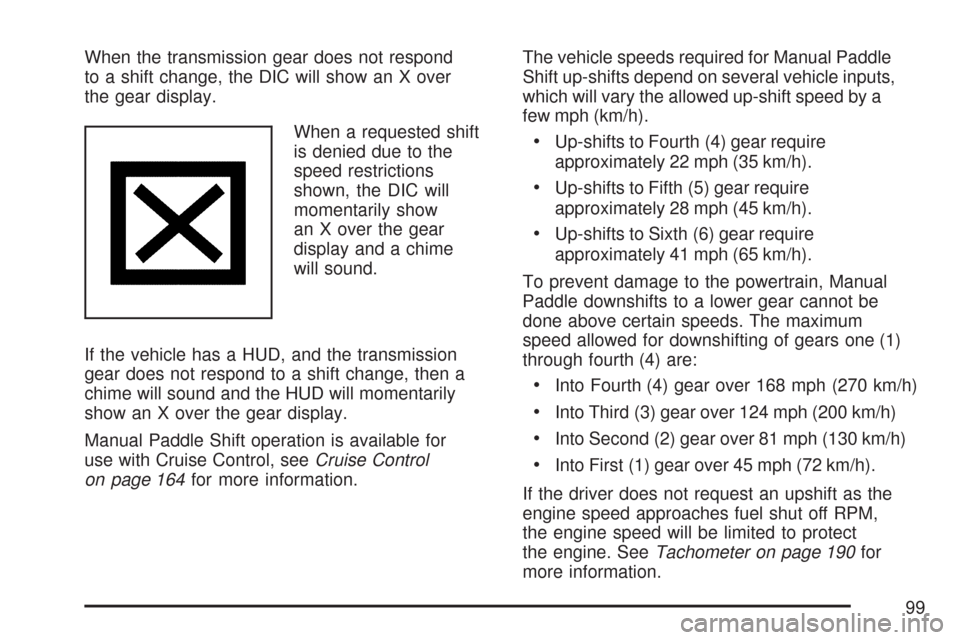
When the transmission gear does not respond
to a shift change, the DIC will show an X over
the gear display.
When a requested shift
is denied due to the
speed restrictions
shown, the DIC will
momentarily show
an X over the gear
display and a chime
will sound.
If the vehicle has a HUD, and the transmission
gear does not respond to a shift change, then a
chime will sound and the HUD will momentarily
show an X over the gear display.
Manual Paddle Shift operation is available for
use with Cruise Control, seeCruise Control
on page 164for more information.The vehicle speeds required for Manual Paddle
Shift up-shifts depend on several vehicle inputs,
which will vary the allowed up-shift speed by a
few mph (km/h).
Up-shifts to Fourth (4) gear require
approximately 22 mph (35 km/h).
Up-shifts to Fifth (5) gear require
approximately 28 mph (45 km/h).
Up-shifts to Sixth (6) gear require
approximately 41 mph (65 km/h).
To prevent damage to the powertrain, Manual
Paddle downshifts to a lower gear cannot be
done above certain speeds. The maximum
speed allowed for downshifting of gears one (1)
through fourth (4) are:
Into Fourth (4) gear over 168 mph (270 km/h)
Into Third (3) gear over 124 mph (200 km/h)
Into Second (2) gear over 81 mph (130 km/h)
Into First (1) gear over 45 mph (72 km/h).
If the driver does not request an upshift as the
engine speed approaches fuel shut off RPM,
the engine speed will be limited to protect
the engine. SeeTachometer on page 190for
more information.
99
Page 153 of 488

Instrument Panel Overview........................ 156
Hazard Warning Flashers.......................... 158
Other Warning Devices............................. 159
Horn.......................................................... 159
Tilt Wheel.................................................. 159
Turn Signal/Multifunction Lever.................. 160
Turn and Lane-Change Signals
(Auto Signal).......................................... 161
Headlamp High/Low-Beam Changer.......... 162
Flash-to-Pass............................................ 162
Windshield Wipers..................................... 162
Windshield Washer.................................... 163
Cruise Control........................................... 164
Exterior Lamps.......................................... 168
Wiper Activated Headlamps....................... 169
Headlamps on Reminder........................... 169
Daytime Running Lamps (DRL)................. 169
Fog Lamps................................................ 171
Twilight Sentinel
®...................................... 171
Exterior Lighting Battery Saver.................. 172
Instrument Panel Brightness...................... 172
Courtesy Lamps........................................ 173
Entry/Exit Lighting...................................... 173
Reading Lamps......................................... 173
Battery Run-Down Protection..................... 173Head-Up Display (HUD)............................ 174
Accessory Power Outlet(s)........................ 178
Ashtray(s) and Cigarette Lighter................ 179
Climate Controls......................................... 179
Dual Automatic Climate Control System.... 179
Outlet Adjustment...................................... 186
Passenger Compartment Air Filter............. 186
Warning Lights, Gages, and Indicators..... 188
Instrument Panel Cluster........................... 189
Speedometer and Odometer...................... 190
Tachometer............................................... 190
Safety Belt Reminder Light........................ 190
Airbag Readiness Light............................. 191
Passenger Airbag Status Indicator............. 192
Voltmeter Gage......................................... 194
One-to-Four Shift Light
(Manual Transmission)........................... 195
Brake System Warning Light..................... 196
Anti-Lock Brake System Warning Light...... 197
Traction Control System (TCS)
Warning Light........................................ 197
Active Handling System Light.................... 198
Engine Coolant Temperature Gage............ 199
Section 3 Instrument Panel
153
Page 157 of 488

The main components of your instrument panel are the following:
A. Air Outlet. SeeOutlet Adjustment on page 186.
B. Head-Up Display Controls (If Equipped).
SeeHead-Up Display (HUD) on page 174.
C. Turn Signal/Multifunction Lever. SeeTurn
Signal/Multifunction Lever on page 160. Cruise
Control. SeeCruise Control on page 164.
Fog Lamps. SeeFog Lamps on page 171.
Headlamp Controls. SeeExterior Lamps
on page 168.
D. Manual Shift Paddles (If Equipped). See
Automatic Transmission Operation on page 95.
E. Driver Information Center (DIC). SeeDriver
Information Center (DIC) on page 207.
F. Instrument Panel Cluster. SeeInstrument
Panel Cluster on page 189.
G. Audio Steering Wheel Controls (If Equipped).
SeeAudio Steering Wheel Controls on
page 269.
H. Windshield Wiper/Washer Lever. See
Windshield Wipers on page 162and
Windshield Washer on page 163.
I. Driver Information Center (DIC) Controls.
SeeDIC Controls and Displays on page 208.J. Center Air Outlets. SeeOutlet Adjustment
on page 186.
K. Hazard Warning Flasher Button. SeeHazard
Warning Flashers on page 158.
L. Audio System. SeeAudio System(s) on
page 244.
M. Climate Controls. SeeDual Automatic Climate
Control System on page 179.
N. Fuel Door Release Button. SeeFilling the Tank
on page 324. Hatch/Trunk Release Button.
See “Hatch/Trunk Lid Release” under
Hatch/Trunk on page 82.
O. Instrument Panel Brightness Control. See
Instrument Panel Brightness on page 172.
P. Power Folding Top Switch (If Equipped).
SeeConvertible Top (Manual) on page 139
orConvertible Top (Power) on page 146.
Q. Tilt Wheel Lever. SeeTilt Wheel on page 159.
R. Telescopic Wheel Button (If Equipped).
SeeTilt Wheel on page 159.
S. Ignition Switch. SeeIgnition Positions
on page 90.
157
Page 161 of 488

ICruise Control. SeeCruise Control
on page 164.
PExterior Lamps Control. SeeExterior
Lamps on page 168.
Turn and Lane-Change Signals
(Auto Signal)
The turn signal has two upward (for right) and
two downward (for left) positions. These positions
allow you to signal a turn or a lane change.
To signal a turn, move the multifunction lever all
the way up or down. When the turn is �nished,
the lever will return automatically.
An arrow on the
instrument panel
cluster will �ash in
the direction of the
turn or lane change.To signal a lane change, just raise or lower the
lever until the arrow starts to �ash. Release
the lever and the turn signal will automatically �ash
three times. If more �ashes are desired, continue
to hold the lever.
If you signal a turn or a lane change and the
arrows �ash faster than normal, a signal bulb may
be burned out.
If a bulb is burned out, replace it to help avoid an
accident. If the arrows do not go on at all when
you signal a turn, check the fuses and check
for burned-out bulbs. SeeFuses and Circuit
Breakers on page 419.
Turn Signal on Chime
A chime will remind you if you leave the turn
signal on for more than three-quarters of a mile
(1.2 km) of driving.
If you need to leave the turn signal on for more
than three-quarters of a mile (1.2 km), turn off the
signal and then turn it back on.
161
Page 164 of 488
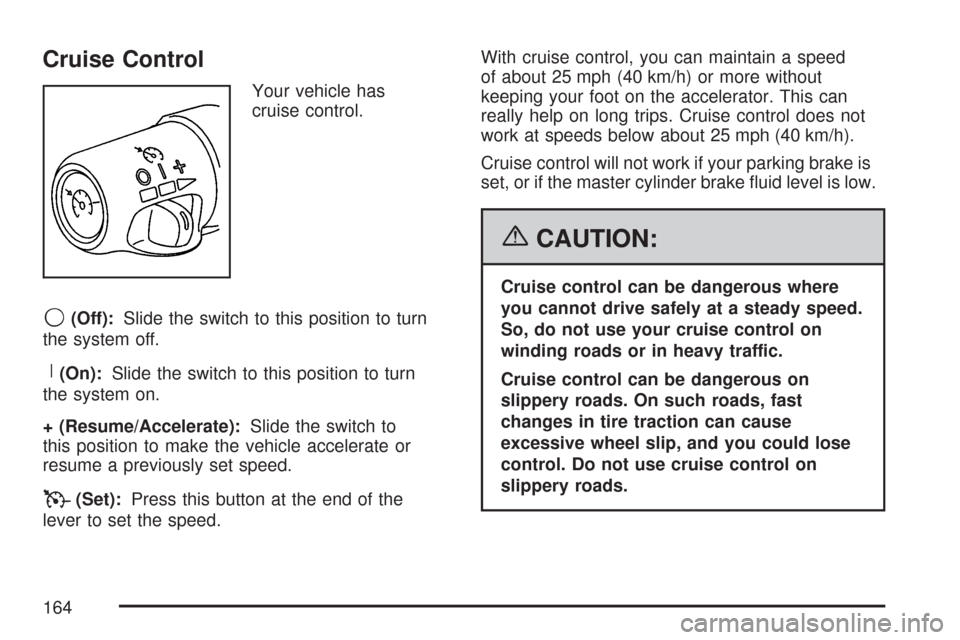
Cruise Control
Your vehicle has
cruise control.
9(Off):Slide the switch to this position to turn
the system off.
R(On):Slide the switch to this position to turn
the system on.
+ (Resume/Accelerate):Slide the switch to
this position to make the vehicle accelerate or
resume a previously set speed.
T(Set):Press this button at the end of the
lever to set the speed.With cruise control, you can maintain a speed
of about 25 mph (40 km/h) or more without
keeping your foot on the accelerator. This can
really help on long trips. Cruise control does not
work at speeds below about 25 mph (40 km/h).
Cruise control will not work if your parking brake is
set, or if the master cylinder brake �uid level is low.
{CAUTION:
Cruise control can be dangerous where
you cannot drive safely at a steady speed.
So, do not use your cruise control on
winding roads or in heavy traffic.
Cruise control can be dangerous on
slippery roads. On such roads, fast
changes in tire traction can cause
excessive wheel slip, and you could lose
control. Do not use cruise control on
slippery roads.
164
Page 165 of 488
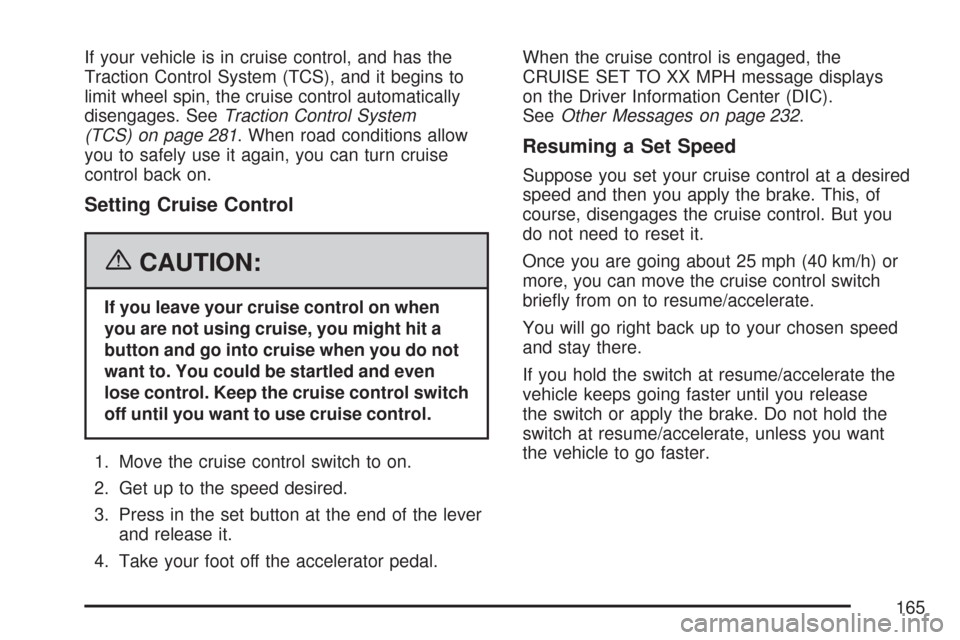
If your vehicle is in cruise control, and has the
Traction Control System (TCS), and it begins to
limit wheel spin, the cruise control automatically
disengages. SeeTraction Control System
(TCS) on page 281. When road conditions allow
you to safely use it again, you can turn cruise
control back on.
Setting Cruise Control
{CAUTION:
If you leave your cruise control on when
you are not using cruise, you might hit a
button and go into cruise when you do not
want to. You could be startled and even
lose control. Keep the cruise control switch
off until you want to use cruise control.
1. Move the cruise control switch to on.
2. Get up to the speed desired.
3. Press in the set button at the end of the lever
and release it.
4. Take your foot off the accelerator pedal.When the cruise control is engaged, the
CRUISE SET TO XX MPH message displays
on the Driver Information Center (DIC).
SeeOther Messages on page 232.
Resuming a Set Speed
Suppose you set your cruise control at a desired
speed and then you apply the brake. This, of
course, disengages the cruise control. But you
do not need to reset it.
Once you are going about 25 mph (40 km/h) or
more, you can move the cruise control switch
brie�y from on to resume/accelerate.
You will go right back up to your chosen speed
and stay there.
If you hold the switch at resume/accelerate the
vehicle keeps going faster until you release
the switch or apply the brake. Do not hold the
switch at resume/accelerate, unless you want
the vehicle to go faster.
165
Page 166 of 488
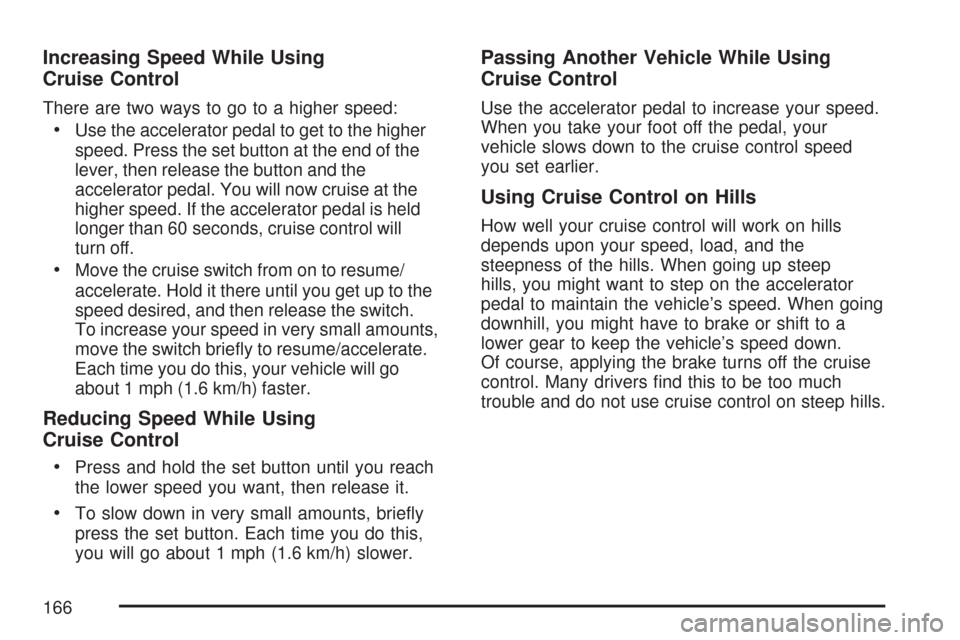
Increasing Speed While Using
Cruise Control
There are two ways to go to a higher speed:
Use the accelerator pedal to get to the higher
speed. Press the set button at the end of the
lever, then release the button and the
accelerator pedal. You will now cruise at the
higher speed. If the accelerator pedal is held
longer than 60 seconds, cruise control will
turn off.
Move the cruise switch from on to resume/
accelerate. Hold it there until you get up to the
speed desired, and then release the switch.
To increase your speed in very small amounts,
move the switch brie�y to resume/accelerate.
Each time you do this, your vehicle will go
about 1 mph (1.6 km/h) faster.
Reducing Speed While Using
Cruise Control
Press and hold the set button until you reach
the lower speed you want, then release it.
To slow down in very small amounts, brie�y
press the set button. Each time you do this,
you will go about 1 mph (1.6 km/h) slower.
Passing Another Vehicle While Using
Cruise Control
Use the accelerator pedal to increase your speed.
When you take your foot off the pedal, your
vehicle slows down to the cruise control speed
you set earlier.
Using Cruise Control on Hills
How well your cruise control will work on hills
depends upon your speed, load, and the
steepness of the hills. When going up steep
hills, you might want to step on the accelerator
pedal to maintain the vehicle’s speed. When going
downhill, you might have to brake or shift to a
lower gear to keep the vehicle’s speed down.
Of course, applying the brake turns off the cruise
control. Many drivers �nd this to be too much
trouble and do not use cruise control on steep hills.
166
Page 167 of 488
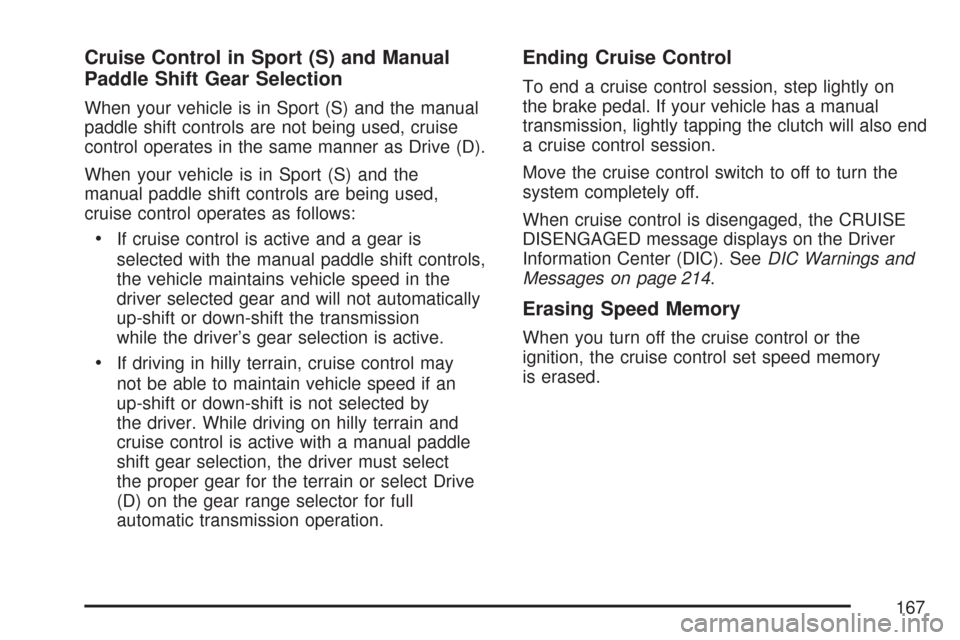
Cruise Control in Sport (S) and Manual
Paddle Shift Gear Selection
When your vehicle is in Sport (S) and the manual
paddle shift controls are not being used, cruise
control operates in the same manner as Drive (D).
When your vehicle is in Sport (S) and the
manual paddle shift controls are being used,
cruise control operates as follows:
If cruise control is active and a gear is
selected with the manual paddle shift controls,
the vehicle maintains vehicle speed in the
driver selected gear and will not automatically
up-shift or down-shift the transmission
while the driver’s gear selection is active.
If driving in hilly terrain, cruise control may
not be able to maintain vehicle speed if an
up-shift or down-shift is not selected by
the driver. While driving on hilly terrain and
cruise control is active with a manual paddle
shift gear selection, the driver must select
the proper gear for the terrain or select Drive
(D) on the gear range selector for full
automatic transmission operation.
Ending Cruise Control
To end a cruise control session, step lightly on
the brake pedal. If your vehicle has a manual
transmission, lightly tapping the clutch will also end
a cruise control session.
Move the cruise control switch to off to turn the
system completely off.
When cruise control is disengaged, the CRUISE
DISENGAGED message displays on the Driver
Information Center (DIC). SeeDIC Warnings and
Messages on page 214.
Erasing Speed Memory
When you turn off the cruise control or the
ignition, the cruise control set speed memory
is erased.
167